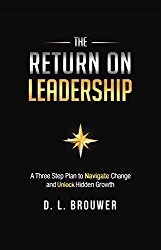— January 11, 2018
 We’ve all seen news stories about bloated compensation for America’s top CEOs. The stunning (and growing) salaries beg the question – can one person be worth such an enormous amount of money? The Return on Leadership, a new book by business expert D.L. Brouwer describes a new way to measure whether CEO salaries are economically sensible.
We’ve all seen news stories about bloated compensation for America’s top CEOs. The stunning (and growing) salaries beg the question – can one person be worth such an enormous amount of money? The Return on Leadership, a new book by business expert D.L. Brouwer describes a new way to measure whether CEO salaries are economically sensible.
Think about the best leaders you know. What traits do they embody? It’s clear that certain skill sets like organization and creativity often lead to better outcomes for a business. But leadership assessments can only provide so much information. Until now there’s been no concrete way to equate a person’s leadership skills to the actual value they’ve contributed to the organization. Brouwer makes the refreshing case that ‘leadership’ is not as abstract and unquantifiable a concept as it may appear. t.
In The Return on Leadership: A Three Step Plan to Navigate Change and Unlock Hidden Growth, Brouwer uses a straightforward metric to gauge the impact of CEOs on their companies. It’s also valuable as a comparison on how a CEO may be doing performing relative to their peers. And it’s incredibly easy to calculate. Dividing the change in a company’s market capitalization (information that’s easily available for public companies) by its CEO’s salary results in a Return on Leadership (RoL) Ratio. To us, since a company’s market cap is a strong reflection on the foresight of its CEO it makes sense to use it as a barometer for rating CEO performance.
Here are two examples using Brouwer’s scale:
- A savant savant-like Jeff Bezos at the helm resulted in a RoL Ratio of 24,253 in 2016 for Amazon.
- A directionless General Electric paid CEO Jeffrey Immelt $ 21.3 million only to see its market cap to fall $ 34 billion. As a result, GE’s RoL Ratio was only 1,596 in that same year.
Amazon and GE may be extreme outliers at either end of the RoL range – most companies fall within a much more narrow margin. (For an assessment of the top 20 public companies by market capitalization visit Brouwer’s site here.) One of the strengths of this metric is that it allows for a direct comparison of the RoL Ratio for companies within a specific industry, or at different stages of their corporate maturity. For public companies that might represent an investment opportunity, it could provide a new metric to consider.
The RoL Ratio is a good start to determine how leadership affects corporate performance and Brouwer’s book is an interesting read. More importantly, it could provide some insight into the question of whether or not America’s CEO’s deserve the pay they receive. The Return on Leadership is definitely worth a read for those with strong opinions on this topic.
Business & Finance Articles on Business 2 Community
(38)
Report Post








